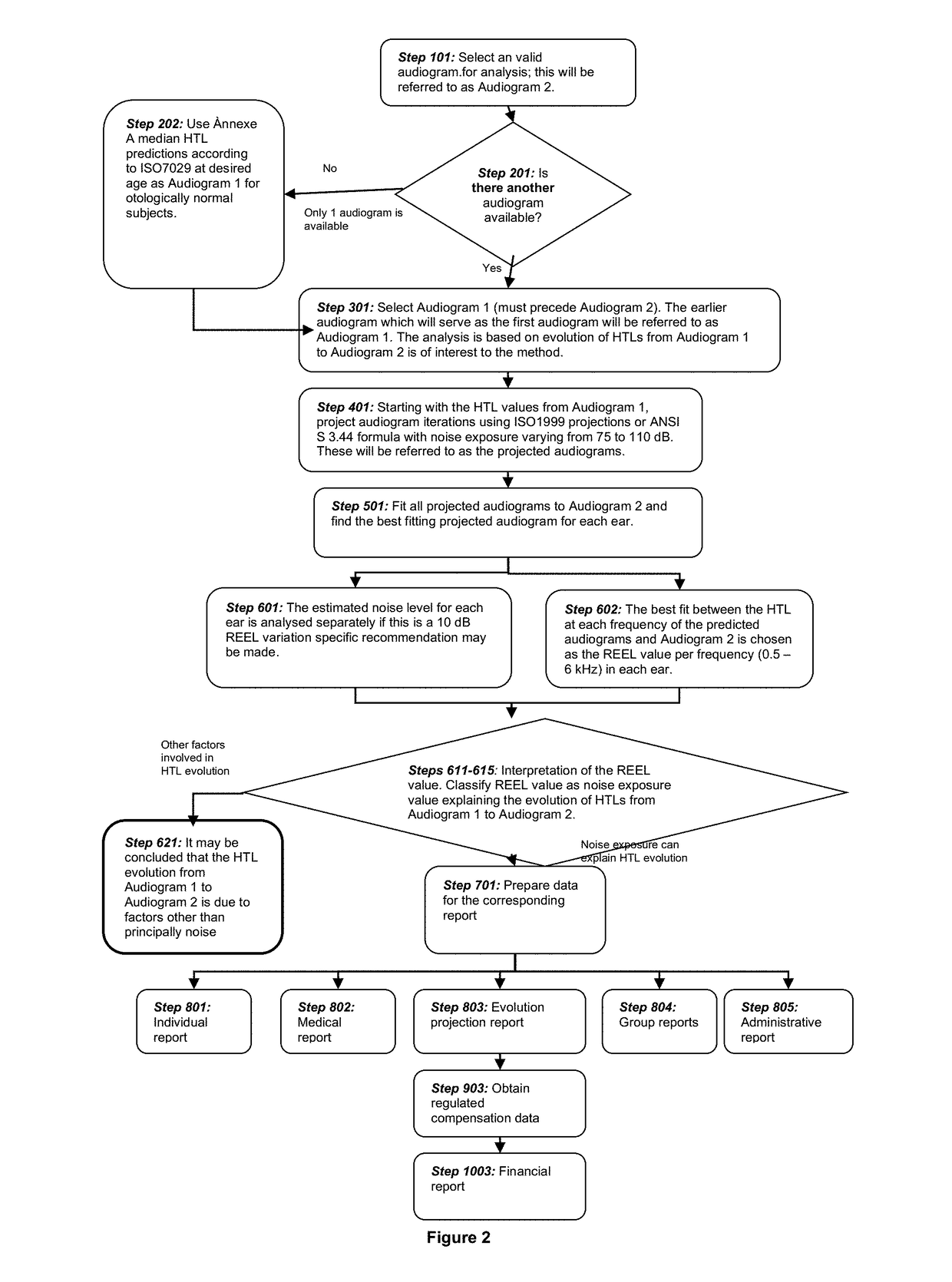Method to estimate real noise exposure levels
a real-time noise exposure and level estimation technology, applied in the field of industrial hygiene, can solve the problems of difficulty in convincing everyone or worker exposed to noise that they have hearing protection, the level of hearing loss, and the hearing loss of workers
- Summary
- Abstract
- Description
- Claims
- Application Information
AI Technical Summary
Benefits of technology
Problems solved by technology
Method used
Image
Examples
example 1
[0162]In this example, iterations of the projected hearing loss according to ISO1999 performed at Step 401 and Step 501 for noise exposure levels ranging from 75 dB to 110 dB are presented for a male with an exposure duration of 39 years from age 21 (corresponding to audiogram A1L) to age 60 (corresponding to audiogram B2L) according to Formula 2. Detailed calculations are provided for one iteration using a noise exposure of level of 90 dB. Values for □ are taken from the table represented at FIG. 12.
[0163]First, the results obtained for the age related hearing loss according to ISO7029 for a 60 year old male are presented in FIG. 13.
[0164]Next, the NIPTS with exposure duration of 39 years is calculated. The results are presented in FIG. 14.
[0165]According to the ISO1999, if (Lex,8 h−Lo)<0 then NIPTS=0. For such cases, the REEL is 75 dB or less. This corresponds to ISO7029 percentiles of 0.5 or better.
[0166]The hearing loss for the six reference frequencies according to ISO1999, ANS...
example 2
[0172]In the following example, an example is developed where the exposure duration is greater than 40 years.
[0173]If t>40 years, t is set to 40 years according to Formula 4 and the calculations are completed similarly to Example 1 above. For example, assume the same person is of age 62 now, therefore t=41. The results of NIPTS are same as the ones of age 62, but with an exposure duration of only 40 years instead of 41 years (i.e if t>40 years, set t=40 in NIPTS projections and proceed). Note, however that the results for HL7029 are simply dependent on the age of individual for Audiogram 2 and are not affected by the t=40 limitation. The results are found in FIG. 20. It is possible to note from this figure that although the NIPTS factor does not change when the duration is above 40 years, the aging factor predicted from ISO7029 certainly affects the total ISO1999 HL prediction of an individual since it is valid until the age of 70.
[0174]If the exposure duration were less than 10 yea...
example 3
[0175]In the present example, ISO1999 hearing loss projections using percentiles other than the median value are presented.
[0176]Using the same example as above, if one uses values of REEL that lie between 10% and 90% of the general population instead of using the median values, the following two different projections per iteration that would be obtained are defined as follows:
HL10%1999=HL50%7029+NIPTS10%-HL50%7029*NIPTS10%120HL90%1999=HL50%7029+NIPTS90%-HL50%7029*NIPTS90%120Where:NIPTS10%=NIPTS50%+1.282*duNIPTS90%=NIPTS50%+1.282*dlWhere:du=[Xu+Yulog(39)](90-Lo)2dl=[Xl+YlIlog(39)](90-Lo)2
[0177]The constants are presented in FIG. 21 and the intermediate results of this example are presented in FIG. 22. The final hearing loss predictions are presented in FIG. 23. Using the SHLFR, we obtain REEL90%=87 dB, and REEL10%=93 dB.
Variations to the Basic Method and Use of Results
[0178]Referring to the selection of two audiograms for Steps 101 to 301 discussed above, it is not necessary to choo...
PUM
 Login to View More
Login to View More Abstract
Description
Claims
Application Information
 Login to View More
Login to View More - R&D
- Intellectual Property
- Life Sciences
- Materials
- Tech Scout
- Unparalleled Data Quality
- Higher Quality Content
- 60% Fewer Hallucinations
Browse by: Latest US Patents, China's latest patents, Technical Efficacy Thesaurus, Application Domain, Technology Topic, Popular Technical Reports.
© 2025 PatSnap. All rights reserved.Legal|Privacy policy|Modern Slavery Act Transparency Statement|Sitemap|About US| Contact US: help@patsnap.com



